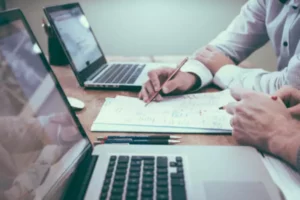What’s a Balance Sheet and Why Do I Need One?
Content

Larger businesses will often create monthly balance sheets, while small businesses or startups typically create them quarterly. Understanding what a balance sheet is and how to read one is crucial for many careers in finance. This financial statement provides invaluable information needed for completing various financial calculations and formulas. Because you need to use balance sheets for these calculations, showing you know these metrics and formulas implies an inherent knowledge.
This account is derived from the debt schedule, which outlines all of the company’s outstanding debt, the interest expense, and the principal repayment for every period. List the current liabilities that are due within a year of the balance sheet date. These include accounts payable, short-term notes payable, and accrued liabilities. Once you’ve set a date, your next task is to list out all of your current asset items in separate line items.
Balance Sheet Templates
The term balance sheet refers to a financial statement that reports a company’s assets, liabilities, and shareholder equity at a specific point in time. Balance sheets provide the basis for computing rates of return for investors and evaluating a company’s capital structure. The Balance Sheet is the statement showing the business’s financial position at a given time. It is the statement showing the value of assets and liabilities of a firm at a certain date.
- Your balance sheet shows what your business owns (assets), what it owes (liabilities), and what money is left over for the owners (owner’s equity).
- If you’re applying for a small business loan, it helps to have something to show the bank that you’ve done your homework.
- Toggl’s balance sheet template gives an overview of your balances in one single view.
- For small privately-held businesses, the balance sheet might be prepared by the owner or by a company bookkeeper.
- Whether you’re looking to become an entrepreneur or you simply want to secure upward mobility in the corporate world, understanding the fundamentals of finance is key.
- This category is usually called “owner’s equity” for sole proprietorships and “stockholders’ equity” or “shareholders’ equity” for corporations.
- While investors and stakeholders may use a balance sheet to predict future performance, past performance is no guarantee of future results.
Please contact your own legal, tax, or financial advisors regarding your specific business needs before taking any action based upon this information. Short-term liabilities include accounts payable, such as monthly invoices owed to vendors and creditors, and notes payable owed to others within the next 12 months. Most importantly, it can help answer questions about whether or not a business is thriving.
Balance Sheet Basics
This helps build trust with investors and creditors and improves a company’s overall reputation. Most income statements include a calculation of earnings per share or EPS. This calculation tells you how much money shareholders https://www.bookstime.com/articles/balance-sheet-basics would receive for each share of stock they own if the company distributed all of its net income for the period. It’s the money that would be left if a company sold all of its assets and paid off all of its liabilities.
The value of balance sheet accounts can be used to calculate ratios that show the liquidity, efficiency and financial structure of a business. While all balance sheets follow the same equation, the types of accounts listed will vary based on the type of business. Product-based companies, such as retailers, sell goods to consumers and have overhead expenses like inventory and real estate. Service-based companies, like dry cleaners or law firms, sell services instead of goods, so they do not typically have inventory or raw products on the balance sheet. The method and time period in which payment is accepted may also change what’s listed in the balance sheet.
A Balance Sheet Will Help Your Business Grow
Balance sheets are one of the most critical financial statements, offering a quick snapshot of the financial health of a company. Learning how to generate them and troubleshoot issues when they don’t balance is an invaluable financial accounting skill that can help you become an indispensable member of your organization. A balance sheet offers internal and external analysts a snapshot of how a company is performing in the current period, how it performed during the previous period, and how it expects to perform in the immediate future. Depicting your total assets, liabilities, and net worth, this document offers a quick look into your financial health and can help inform lenders, investors, or stakeholders about your business.
What are the main objects of balance sheet?
The purpose of the balance sheet is to reveal the financial status of a business as of a specific point in time. The statement shows what an entity owns (assets) and how much it owes (liabilities), as well as the amount invested in the business (equity).
Then, you’ll subtotal and total these the same way you did with your assets. A balance sheet gives you an overview of your business’ financial standing. It’s important to note that this balance sheet example is formatted according to International Financial Reporting Standards (IFRS), which companies outside the United States follow. If this balance sheet were from a US company, it would adhere to Generally Accepted Accounting Principles (GAAP). After you’ve identified your reporting date and period, you’ll need to tally your assets as of that date.
Balance Sheets vs. Other Financial Statements
Some companies issue preferred stock, which will be listed separately from common stock under this section. Preferred stock is assigned an arbitrary par value (as is common stock, in some cases) that has no bearing on the market value of the shares. The common stock and preferred stock accounts are calculated by multiplying the par value by the number of shares issued. The balance sheet provides an overview of the state of a company’s finances at a moment in time. It cannot give a sense of the trends playing out over a longer period on its own. For this reason, the balance sheet should be compared with those of previous periods.
What are the 3 key features of a balance sheet?
1 A balance sheet consists of three primary sections: assets, liabilities, and equity.
On a balance sheet, assets are usually split into current and non-current assets. Shareholders’ equity, on the other hand, is the term used for a corporation with stockholders instead of a sole proprietorship. When a business decides to reinvest earnings into the company itself, that money goes into this category on the balance sheet.
It’s a tool for looking inside your business to outline what it’s really worth.
Each side of the equation must match the other—one account must be debited and another credited. Any amount remaining (or exceeding) is added to (deducted from) retained earnings. Includes non-AP obligations that are due within one year’s time or within one operating cycle for the company (whichever is longest). Notes payable may also have a long-term version, which includes notes with a maturity of more than one year. Property, Plant, and Equipment (also known as PP&E) capture the company’s tangible fixed assets.
- Generally accepted accounting procedures (GAAP) dictate that companies must list the most liquid assets and short-term liabilities first, which is why there is usually two subsections in assets and liabilities.
- Visit our Developer Center to find Payments APIs, developer tools, and documentation.
- Investors can get a sense of a company’s financial wellbeing by using a number of ratios that can be derived from a balance sheet, including the debt-to-equity ratio and the acid-test ratio, along with many others.
- The balance sheet information can be used to calculate financial ratios that give investors a general outlook for the company.
- The balance sheet provides an overview of the state of a company’s finances at a moment in time.
- Chase offers a wide variety of business checking accounts for small, mid-sized and large businesses.
Consider enlisting a bookkeeper for day-to-day accounting and a CPA to prepare and analyze statements to help plan your financial future. On the other side of the equation are your liabilities, both short- and long-term, which are the monetary obligations you owe to banks, creditors, and vendors. Owners’ equity refers to the money that the owners of the business originally invested. Unlike liabilities, this money generally isn’t expected to be paid back fully for some time, likely until the business is sold to a third party or shuts down for some other reason. Expressing the total as percentages makes it easier to identify trends and patterns of a company’s financial performance as well as comparing to industry benchmarks and competitors. A balance sheet should be used by companies to monitor their financial health and make informed decisions about their operations.
Business Savings
A balance sheet is a financial statement that communicates the so-called “book value” of an organization, as calculated by subtracting all of the company’s liabilities and shareholder equity from its total assets. In contrast, the income and cash flow statements reflect a company’s operations for its whole fiscal year—365 days. This practice is referred to as “averaging,” and involves taking the year-end (2019 and 2020) figures—let’s say for total assets—and adding them together, and dividing the total by two.
